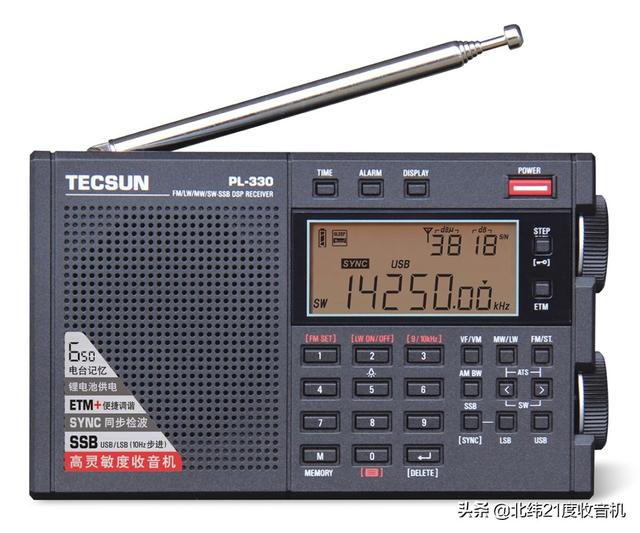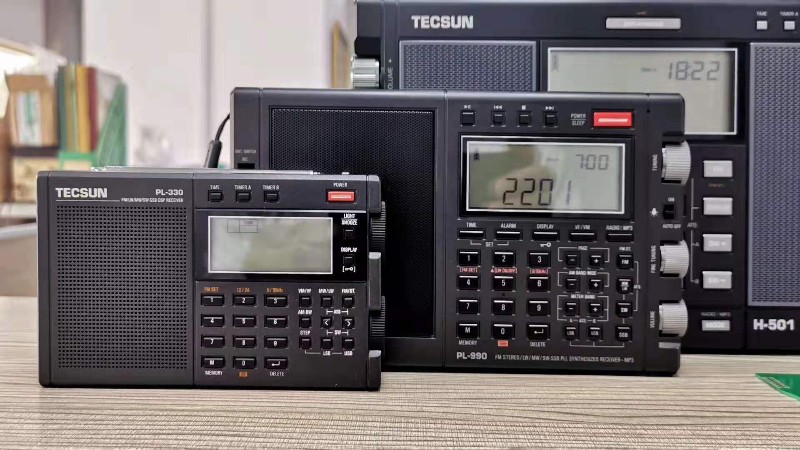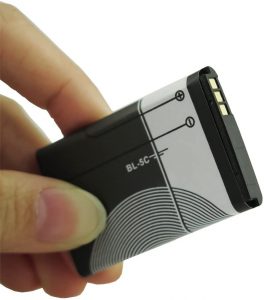Many thanks to a number of SWLing Post readers who shared a link to this website (in Chinese) with photos and details of the new Tecsun PL-330. Note: The server hosting the PL-330 page has been unreliable the past few days.
Some of you might recall the PL-330 in photos of the new Tecsun product line we posted last year. Recently, a handful of preliminary working prototypes have been produced, so I reached out to my trusted Tecsun contact for more information. Here’s what I’ve learned:
Position in Tecsun product line
In terms of the Tecsun product line, the PL-330 appears to be the successor to the venerable Tecsun PL-310ET and/or PL-380.
The PL-330 will have features these legacy Tecsun models do not have, namely:
- synchronous detection,
- single-sideband reception,
- and an upgraded ETM (auto tune and store) feature.
It also appears the SSB tuning steps could be as fine as 10 Hz. Most impressive, if true.
Size
I refer to radios in this size class as “ultra-compact.”
The PL-330 measures 139 × 85 × 26 millimeters (5.5 x 3.3 x 1 inches). Its form factor is very similar to the PL-310ET, but much thinner in profile. The total depth of the radio is only 26 mm.
I love the idea of an even thinner profile, although this certainly limits the type of internal battery that can be used.
Battery
The PL-330 is powered by a single BL-5C lithium battery.
In my world, this is a bit of a negative, but I’m sure the BL-5C was one of the only viable battery options for a radio that’s only 26mm thick.
On the plus side, the BL-5C is widely available, affordable, and can be charged internally.
On the negative side?
Well, I find that the overall capacity doesn’t match that of, say, three AA batteries. Also, I find that the battery’s longevity (meaning, how many charge cycles it can handle) is not that impressive–arguably worse than any other rechargeable battery system I’ve used.
Another reason I prefer AA batteries in compact portables is I know no matter where I travel, I can easily purchase them at almost any retailer, airport, or even hotel, in a pinch. In the past, when I’ve traveled with radios that use the BL-5C, I simply carried a fully-charged spare in a poly zip-lock bag (to protect the battery contacts from inadvertently shorting.
In addition, when I fly, I like to carry as few Lithium batteries as possible.
Perhaps, however, I can find a very high quality BL-5C to use in the PL-330? I would appreciate any leads from readers.
Performance
Since the preliminary prototypes were more or less mechanical prototypes and lacked most of the features planned for this model, there are no performance reports as of yet. In fact, I would be skeptical of any reports you might read in advance of the final production model.
Availability
Like the PL-990 and H-501, there are no reliable estimates for availability or shipping yet. The Covid-19 pandemic has slowed down this process. Most likely, the PL-330 will be released after the PL-990 and H-501, but that isn’t even certain.
Stay tuned!
The PL-330 will have a number of other features and specs, but these are early days and I prefer sticking with what we do know now. As soon as I learn more, I’ll post updates–bookmark the tag PL-330.
Note this reddit thread with an English translation of the Chinese page I mentioned at the beginning of this article (thanks, Tom Daly). It mentions more details, but again, it’s such early days I prefer to stick with what has been confirmed. As with any product in development, a number of changes could occur before the first production run.
Of course, I will review and evaluate the export version of the PL-330 when as soon as it’s available. Stay tuned!
Do you enjoy the SWLing Post?
Please consider supporting us via Patreon or our Coffee Fund!
Your support makes articles like this one possible. Thank you!





It’s such a shame it doesn’t use BP-4L form factor Li-Ion battery…. it holds like 2,7-3x, more charge (1500mAh vs 500…600mAh) and is of the same thick, just LxW is bigger by one centimeter… The same depth/thickness.
Nokia makes. a 2450 ma bl-5c. avail from amazon for $14. .
I just read Jay Allen’s review of the pl-330 and he seems to be getting very good results from the battery.
https://aliexpress.ru/item/4001204792431.html
Hello everboy,
i just got an information from a good friend of mine living in China concerning the Tecsun PL-330.
He wrote that the Tecsun PL-330 that are on sale in the moment have no
CE or FCC sign on the radio. That could give problems with the customs when you import
the radio.
I am writing from Germany and the customs in Germany says no to such imports
due to strong regulations by the EU.
Thats just for info
Hi, Armin,
Yes, it’s my understanding that these preliminary units are only for domestic (China) distribution.
Thanks for the note!
Cheers,
Thomas
and a video of it in reality (if possible to join it with my just previous post with the official full specs link, thanks
https://www.ixigua.com/i6799744975606120971/?logTag=EyEi0QT5yghMklHmlOtFq
also here they have the first review
http://www.myzaker.com/article/5efb55178e9f097c5722cbad/
Hi there again … i was just about getting a pl360 or pl310et because i could not wait … but now i see there is already out? any way to get it here in Greece or at least Europe?
https://item.taobao.com/item.htm?ft=t&id=621056204664
also seems they published fully specs
http://bbs.tecsun.com.cn/0002.asp?open=642785
i am not sure if google translates well … will be available from 1 july for 45 euros? (just 50 $) first 200 pieces (limited stock) it explains how to post but how about abroad?
Thanks the blog & the dx friends
…why NO vhf (Air Band) ….? ……..has every radio manufacturer given up on the air band/long wave/morse code . and FULL AM spectre.
That’s a limitation of Si4735. On the XHData D808 the solution was to include a TA7358 to convert the air band to 10.7MHz and send it to the DSP chip for demodulation. This created an interesting behaviour: the tuning on air band is seamless, with little or none chuffing when turning the VFO knob.
I wonder what Tecsun see as their audience is.
Single Side Band is not transmitted by any broadcaster. The real problem is to set the Beat Frequency Oscillator (BFO) frequency accurate to be within 10 Hz of the frequency of the original not transmitted carrier so that the pitch does not get changed which is important for music.
The synchronous reception should improve reception of multi-reflected signals from the ionosphere causing phasing errors. This will of course be dependent on the locking of the BFO to the carrier frequency in the presence of noise and phasing errors.
Tecsun Australia is selling a Digital Radio Mondiale receiver which is a badge engineered Gospell receiver. When is Tecsun going to design a new technology receiver which is capable of receiving DRM and DAB+ where all but the tuning is almost identical.
There’s more to SWLing than AM listening; not all of us are interested in broadcast stations. For example, I’m much more interested in the utilities side of things, so SSB gets the most use. Some strange people are even into listening to Flightwatch / LDCC, or even hams on HF…
Most of the Tecsuns – at least, the digital display ones – do SSB (and synch detection) either entirely in firmware (e.g the models using a Si47xx), or using a (free-running but tuned in the case of SSB; locked to the carrier in the case of synch detection) PLL BFO. Both methods have their advantages though it’d be fair to say that, at least in the Tecsun implementations, the firmware method is less than optimal – hence all the complaints about e.g. the PL-880 being all warbly and chirpy on weaker signals as it drops in and out of lock.
They also provide sideband choice during synch detection (unlike, say, the old Sony ICF-2001 which required tuning back-and-forth to ‘select’ the sideband), which is particularly useful for escaping adjacent channel interference.
My guess is to explore the same niche of C Crane Skywaves SSB and XHData D-808, both have SSB and have been considered good portables in many reviews.
“I wonder what Tecsun see as their audience is.”
My guess: us. While some of their sets might be easily exported to less developed areas, the more expensive ones probably aren’t. This includes ones that, to us, are comparatively cheap. So they’re chasing a rather small set of hobbyist dollars. Some people like SSB listening. I can’t say I’m one of those, as most times I tune in utility stations, I listen for five minutes then think “Why am I voluntarily listening to this thing when I get nothing from the broadcast”, but others do. So if they want to sell to people interested in the hobby who are located in more developed regions, they will add that feature both to attract customers and to make it more likely that the people who review units, who are most likely quite into the hobby, will review theirs.
That Lithium-Ion BL-5C battery (1020mAh) came 2005 for Nokia phones ! Interestingly, its a original Nokia battery code ! Nothing to shame .
Except that Nokia stopped making _real_ BL-5C’s eons ago. All that are available are generic Chinese clones which, owing to low demand, are often languishing on warehouse shelves month after month, losing what little capacity they have left. Couple that with the fact that cost-cutting is so common in the manufacturing of Chinese Li-Ion cells that the clones are usually far below the rated capacity of the original that they are copying. All in all, a very poor design choice IMHO and an absolute showstopper for me.
You can buy them, still cheap, from makers like Duracell. But I don’t like this BL-5C ideia either.
If there’s an external power port one can always have a AA holder of the correct cell count to plug into the radio. eBay has every cell holder known to humankind, some are enclosed and have a built in power switch. I’ve had fair success using self adhesive Velcro tabs to keep such a cell holder where I want it to be.
It will be interesting reading reviews of the sync feature. Hopefully, sync will work better on the PL-330, PL-990 and the H-501 than on the PL-880. It would be great if sync works as well as on the PL-660 and PL-680.
I am also not a fan of the battery type but the battery may be necessary if Tecsun chose to go with a passive radiator speaker.
Agreed!
I share your concern about lithium batteries – they are great for cameras, phones and the like, but when a radio form factor that could accommodate AA batteries goes down the lithium battery route I’m puzzled. The PL-310ET is already very compact and I never have to fret about getting batteries in an emergency.
And, frankly, the 310ET is a wonderful little radio. It remains to be seen if the new PL-330 could match its performance–a pretty high bar for a radio in this price class!
I can’t say I agree. All the sets I’ve seen with lithium batteries also have USB charging. All the sets I’ve seen with AAs have no recharging or arbitrary (not included) barrel jacks. That means that, if I do run the set out of power somewhere unusual, I either have to plug it in or go about finding AA cells to purchase. Even if I forgot the cable, which I rarely if ever do, I find it very easy to buy those as well. If I don’t forget the cable, recharging is easy, free, and doesn’t require me to search anywhere. It may be easy to find AAs in most places, but I find it very easy not to need to.
On the topic of flying with lithium cells, while they can get damaged, so can any other type of batteries. There have been many times when I’ve gone to use some AA or AAA-powered device only to find that it’s dead, the batteries inside it have leaked, and I now have to clean up and find new cells. No battery type is perfect.
Actually, the Tecsun PL-310ET, for example, can internally charge NiMH AA cells. Simply switch it into charging mode (via a key combo) and charge it via the MiniUSB port. I believe the PL-380 has the same recharge function.
You are correct, Thomas. The PL-380 can also internally charge its NiMH AA cells. I’ve been doing it for the past two years with no issues.
You are also correct that the bar has been set quite high with both of these (non-SSB) receivers.
Rationale for Purchasing the CountyComm GP-5/SSB (GEN 3)
Over the past four years, I have purchased three SW radios. In May of 2016, I purchased the Tecsun PL-880; in March of of 2018, I purchased the Tecsun PL-380; and, now, in April 2020, I’ve purchased CountyComm’s GP-5/SSB (GEN 3).
Why? Because after reading this SWLing Post, it doesn’t look as if the export version of Tecsun’s new PL-330 will be ready for purchase anytime soon.
So I decided to take another look at the GP-5/SSB, based on its relatively solid performance reviews (Thomas Witherspoon, Jay Allen, eHam, etc.) and overall positive feedback from SWLing Post readers.
As a result of reviewers comments and observations (see below), I concluded: the CountyComm’ GP-5/SSB would be a very good choice, especially for someone who is looking for a true ultra portable with SSB capability at a reasonable price ($89.95).
The CC Skywave SSB is the only other ultra-portable SSB currently available, but at a much higher price ($160.49 from Ham Radio Outlet). Although that price does includes sales tax (7%) and shipping, that’s the best out-the-door price I’ve seen on that radio. But does that expenditure represent a good value? – even with its weather/aviation band channels.
What I concluded to be a good value was: the CountyComm’s GP-5/SSB bundled with a GP-5 Desk Pod shipped to my address for a discounted total of $100.49.
Overall Reviewer Assessments
Pros
• Does have SSB.
• Features Silicon Labs Si4735 chip.
• Frequency coverage ranges from 150 kHz to 30 MHz.
• Uses 3 AA batteries and can recharge Ni-MH batteries while in the radio.
• Fine SSB tuning step = 10 Hz.
• Unique/Unusual form factor (a Pro and a Con).
Cons
• No synchronous detection.
• No keypad – requires judicious use of the receiver’s 250 SW memories to facilitate navigating the entire SW spectrum – not recommended for those not willing (or able) to put in the necessary pre-programming work.
• No stand – the work-around for this is to purchase the GP-5 Desk Pod, a machined Canadian hockey puck, which is designed to keep the GP-5 vertical – and prevent it from falling over – a worthwhile option in my opinion, even @ $19.95.
Batteries that are not rechargeable have for some time been prone to leaking. I used to keep them around just in case, but most either leaked, corroded, or both.
Now I keep Enloops as backups to my go batteries kept in a smart charger.
I won’t say that rechargeables don’t leak. Just not offen enough to be bothered with.
Just remember to use acid not alkaline cleaning to remove rechargeable leakage. (White vinigar, not baking soda)
thanks for the info … they should make it to accept AAA recharge batteries as well (see Imperial Dabman 12 DAB+) … bl-5c alone is a failure because these are clones and are too long on store shelves … if ever ?his radio comes out with bl-5c only & keep scanning stations & changing bands & especially if you use the light, bl-5c will not last more than 1 hour because the mah are not enough for that